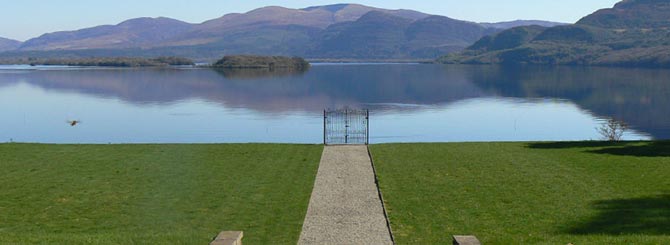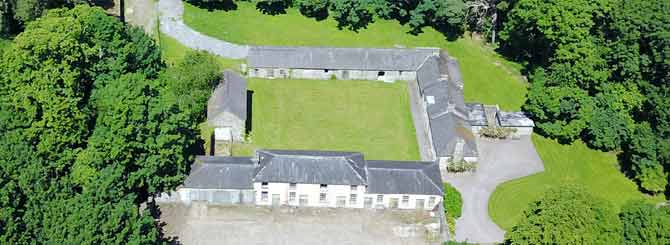An Old Story for New Irish Whiskey

You won't have heard of Maurice O'Connell. Nor will you have heard of his whiskey.
The whiskey is so new it's not even on the market yet, although it has a name: The Liberator. It involves a disused 300-year-old stone cowshed and a couple of outbuildings, some ex-Port and ex-Bordeaux barrels and a hefty bond handed over to the Irish Revenue department. You could call it a garage whiskey; the sort of thing that springs from a small space, fastidious attention to detail and a generous helping of entrepreneurial drive. But the story starts indoors, with an 19th-Century oil painting.
The painting is a portrait of Daniel O'Connell. Those with a grasp of Irish history will think, at this point: Aha! The Liberator! Of course! Daniel O'Connell was the driving force behind 19th-century Catholic emancipation in both Ireland and Britain, and his belief in change by peaceful means was an inspiration to Mahatma Gandhi and Martin Luther King. He has been an inspiration to the whiskey business of his great-great-great grand-nephew, however, because the family had a business importing spirits from all over Europe – you could call him the gift that goes on giving.
What you need, if you’re starting a small-scale whiskey business from scratch, with no background in drinks, is a story. You need an ability to get on top of your subject pretty fast, it's true, plus enough loose change to buy the barrels and hand over that bond to the Revenue, and you'll need the odd disused cowshed, but Maurice had those. The loose change came from a career in property development, and the cowshed came with the family property: the O’Connells and his mother's family, the MacCarthys, have been in this part of Ireland for about 900 years, and Daniel's brother built this house, called Lakeview House, on the shore of Lough Leane.
In the 17th Century England imposed excise duties on imported drink. But, says Maurice, "we didn’t feel we should disturb our business because the English had brought in duties. At Derrynane there was a natural harbor, hidden from the sea, and it was an O'Connell kingdom where the Revenue men couldn't get in. When they occasionally did they met with not terribly pleasant ends."
By about 1820 another Maurice O'Connell had expanded the business and was trading with various cousins in Bordeaux – families like the Miailhes, MacCarthys and Bartons, of whom you'll have heard – "and decided the family needed to go legit". After that, one gathers, it wasn't quite as exciting. "And now we're in the hooch business again."
Full disclosure: the O'Connells are friends of mine. They first mentioned the possibility of whiskey to me a couple of years ago, and my reaction was, um, yes, nice idea, but how? Irish whiskey is Jameson, Powers, Redbreast, Bushmills – all big operations, with acres of tanks and warehouses, and big budgets. The rules used to say that the minimum still size was 1800 liters, which ruled out small-scale operations. "But Dingle Whiskey set up a smaller still about 10 years ago, and got permission," says Maurice. "So now it's possible."

But not easy. This is only the second bonded warehouse in Kerry, and getting the Revenue to agree to it took a while. This is still pioneer territory. In a couple of years there'll be a pot still in the old carriage house, and in the field beyond – the Hilly Field, it's called – there is barley ripening. Olympus barley last year; Laureate this year. But not that much of it, compared to the big boys.
"Malting was another issue. There are two malting companies in Ireland, one in Kildare and one in Cork, and they handle batches of 100 and 120 tons. We get 10 tons off The Hilly Field, though we'll get 30 tons this year. They would have put ours into a bigger batch and given us 10 tons back. But we wanted our own back; we want authenticity. We eventually found a guy in Kildare who will do five-ton batches."
Maurice reckons eventually to produce about a third of the barley he needs. The rest will be bought in as spirit, and finished here, in the mild, rainy, changeable climate of western Ireland, and in the best casks he can afford. "I'm careful about the casks, and getting more and more careful. Sometimes they won't tell me where the casks are from. So I have someone in Bordeaux scouting for me, and everything comes with provenance." The first batch is from Portugal – ex-Tawny and ex-Ruby Port; others have just arrived from a leading Médoc château.
But cowsheds are cowsheds and barrels are barrels, and they were not made for each other. The industry-standard pallets measure 1300cm. The warehouse doors are 1200cm wide. And while you can get a forklift into the warehouse, it can't turn round, so all moving must be done by hand. "A 225-liter barrel, full, weighs a third of a ton," says O'Connell. Some of the barrels are 30 years old, and he was initially nervous of moving them too much, partly because coopers are rare as hen's teeth in Ireland, and partly because the Revenue would demand €6000 ($6550) duty for each lost cask. The first cooper he located insisted that no sampling could be done without his presence, "and he charged as much as a solicitor. I had to put my foot down at the bills, but I didn't know if I could manage on my own. But there's a cooper now in Co. Mayo [a couple of hundred miles to the north], and flying him here is cheaper than using the first guy."
The blend, as I write, is being finally decided before launching next month. It will probably be finished half in Tawny and half in Ruby Port casks, and from what I've tasted, it combines weight and delicacy. And given all the investment, it feels like one of the most expensive drinks I've ever tried.
But that's nothing remarkable. How much does it cost to start making sparkling wine from scratch in England? Probably a lot more. Start-up costs are always high. There was the bond required by the Revenue for the bonded warehouse (€100,000 initially, but now €250,000); the Revenue, says Maurice, did their best to be helpful, possibly because he didn't fill them in on the details of the previous family relationship with Revenue men, and in the end took it from him directly rather than via his bank – which was going to charge 3 percent on top. The cowshed had to be re-roofed and (obviously) cleaned. The carriage house had to be turned into a still house. Those barrels from Bordeaux cost €400 each. "Alarms and sensors cost €1300 each, and we need four. Smoke alarms are €1200 each, and we need six. We've spent €1.35 million so far and it will be €3.8m before we're through," says Maurice. "We're serious about this."
Choosing the name was pretty ticklish, too. "O'Connell" was already taken somewhere or other. The name of the land around is Maulagh, which translates as "abounding in hillocks". "That would be turned into 'abounding in pillocks'," says Maurice. (Non-British English speakers can Google the meaning.) They also decided to avoid the Chinese inscription over the gate to the warehouse yard, which was brought back by an ancestor and which translates as "House of Contentment" – a euphemism, of course. So they settled on Wayward Irish Spirits for the name of the company – British Prime Minister Robert Peel referred to Daniel O'Connell as "that wayward Irishman" – and The Liberator for the brand. There'll be a visitor centre – the Ring of Kerry tourist route runs past the front gates – and there might well be a gin, as well, with botanicals sourced on their own land.
What the story of The Liberator doesn't relate is that in his later life Daniel O'Connell became an advocate of Temperance. Perhaps we won't go into that now.
No comments